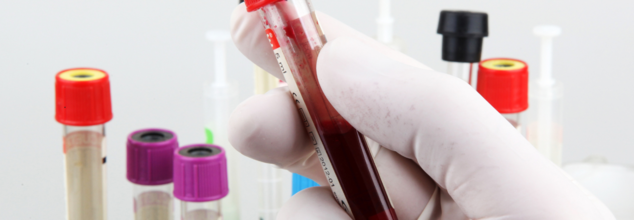- Health Conditions A-Z
- Health & Wellness
- Nutrition
- Fitness
- Health News
- Ayurveda
- Videos
- Medicine A-Z
- Parenting
A Blood Test For Irritable Bowel Syndrome Can Help Build A Better Diet

Diet plays a very important role when it comes to your health. There are many people who have to adhere to strict diets because of certain conditions they have. While the basic understanding that we need all kinds of foods to fulfill our body’s needs, sometimes these foods can also cause harm to your body. For example, lactose intolerant people cannot eat or consume any kind of dairy product as their bodies do not have the necessary compounds, known as lactose, to break down dairy foods. Similarly, there are many foods that may be ok for others to consume, but not for people who have digestive issues like IBS. But this new clinical trial may be able to help us know what food we can eat based on our blood test! The blood test, called inFoods IBS, looks for a special type of antibody in the blood. Antibodies are like tiny soldiers that our bodies make to fight off things that could make us sick.
IBS is a very common problem, affecting a large number of people. Many people know that what they eat can make their IBS symptoms worse, but it's often hard to figure out exactly which foods are the culprits. This is because everyone is different, and what triggers one person might not trigger another. Doctors hear from patients all the time, asking for help in determining which foods are causing their problems. So, finding a reliable way to pinpoint those foods is important. This test is attempting to provide that reliability.
How Does This Blood Test Work?
Basically, the test is looking for an antibody called IgG. When the gut reacts badly to a food, it makes more of this IgG antibody. The test checks for reactions to 18 common foods, like wheat, milk, and certain fruits. If the test finds high levels of the IgG antibody for a certain food, it means that food is likely causing problems. Therefore, the patient should try to remove that food from their diet.
Many people with IBS struggle to find relief from their stomach pain and discomfort. This new study looked at whether a special blood test could help. The idea was to see if the test could tell people which foods were making their IBS worse. The results were encouraging. When people changed their diets based on what the blood test showed, about 60% of them felt less stomach pain. This is better than the 42% who felt better when they just tried a general diet change. This shows that the blood test might be a useful tool for people with IBS to get real relief.
How Does This Personalized Nutrition Approach Work?
Many doctors suggest that people with IBS try elimination diets, where they cut out certain foods to see if their symptoms improve. However, these diets can be very hard to follow, because they often require people to cut out a lot of different foods. Doctors are always looking for ways to give patients care that's tailored to their specific needs. In the case of IBS, that means figuring out exactly which foods each person should avoid.
This blood test is a step in that direction. Experts are calling it a move towards "precision nutrition." This means that instead of giving everyone the same diet advice, doctors could use the blood test to create a personalized plan for each patient. While more research is needed, this test brings hope that doctors will soon be able to give much more precise dietary recommendations to those people that suffer from IBS. While this test is yet to be approved by FDA, it could be a world of comfort and ease for people who suffer with IBS.
All Men Should Not Get Screened For Prostrate Cancer, Says UK Screening Committees; Who Can?

Credits: iStock
Screening for all men is "likely to cause more harm than good", says the UK National Committee. This recommendation is based on a clinical trial called Transform, which is now filling gaps in the evidence on how screening could be safely rolled out to other groups.
As of now, as per the recommendation, men who are between the ages of 45 and 61 should be screened every two years, if they have specific genetic mutations called BRCA variants.
The UK National Screening Committee recommends:
- No screening for black men due to "uncertainties" around the impact due to a lack of clinical trials in black men
- No screening based on family history
Why Is The New Recommendation Asking People To Not Get Screened For Prostrate Cancer?
As per the clinical study and the Cancer Research UK, of the 1000 men who get screened between the age of 50 to 60 for PSA test or the prostate-specific antigen test, around 100 have a positive PSA test. Of them, 34 have a positive MRI and receive a biopsy. Then only 28 are diagnosed with prostrate cancer. Of those 28, 10 are offered active surveillance, 13 are offered surgery or radiotherapy, and 4 need surgery or radiotherapy, while 1 need any other treatment.
However, the Cancer Research UK notes that while 1000 men are screening, and 28 diagnosed, only 2 lives could be saved, with 20 being over diagnosed, this means they have a slow-growing tumor that does not need treating, and of them 12 men will receive treatments that do not benefit them, rather harms them. These harms come in forms like being unable to control your bladder, or maintain an erection.
Is Prostrate Cancer Screening Recommendation Fit For All?
While experts say it is, patients are disappointed. Sir Chris Hoy, a terminal prostrate cancer patient says he was "disappointed and saddened" by the new recommendations as BBC reports.
However, Prof Freddie Hamdy, who is a urological surgeon in Oxford tells BBC: "The diagnosis of prostrate cancer in a healthy man is hugely disruptive event, with potential to affect quality of life, very significantly, for many years."
"It cannot be done lightly, men need to be really well counselled and informed before the 'snowball' starts. Before you know it, you are on the operating table having your prostate removed – and we see examples of that all the time," he said.
The screening committee’s decision is not final. It marks the beginning of a three-month public consultation period, after which the committee will reconvene and present its final recommendations to ministers in England, Wales, Scotland, and Northern Ireland. Each nation will then make its own decision on prostate screening.
England’s Health Secretary Wes Streeting said he supports screening “if backed by evidence” and promised to review the data “thoroughly” ahead of the final guidance expected in March.
Reactions to the draft recommendations have been sharply divided. Cancer Research UK welcomed the consideration of screening for men with faulty BRCA genes and agreed that, for most men, screening could currently do more harm than good.
But others strongly disagreed. Sir Chris Hoy said he was “extremely disappointed and saddened,” calling the BRCA-specific recommendation “a very small step forward” that falls short. Sharing his own experience, he emphasised that “early screening and diagnosis saves lives.”
Prostate Cancer UK CEO Laura Kerby also expressed being “deeply disappointed,” saying the decision will “come as a blow” to tens of thousands of men.
Prostate Cancer Research criticized the move as “a serious error that ignores modern evidence,” calling it a missed opportunity for Black men and those with a family history.
Sleep Hack That Can Help You Sleep In Minutes, According To Neuroscientist

(Credit-Canva)
Many people struggle to fall asleep because their minds race with worries about the next day or even old memories. To stop this mental chatter, some try complicated breathing exercises or relaxation hacks. However, a simple neuroscience trick involving temperature might help you drift off instantly.
Neuroscientist Kyle Cox suggests that you can fall asleep in seconds simply by placing something cold on your forehead when you go to bed. He explains that this method has been backed by sleep clinics and can be highly effective.
Sleep Hack That Could Help You Sleep Quicker
Researchers have learned that the temperature right on your forehead controls whether your brain stays active or decides to rest.
When the front part of your brain, called the frontal lobe, gets cooled down by even a little bit, just one degree, it automatically tells your body to start producing the chemicals needed for sleep.
The cold also quickly slows down all that busy mental chatter because the part of your brain that handles thinking (the prefrontal cortex) literally cannot work as hard when it is being cooled down.
A 2018 study published in the Sleep Journal also found similar results through a device that that cooled the forehead temperature as a treatment for insomnia. The device improved things like the time it took to fall asleep compared to the patient's own baseline sleep and the time it took to enter different stages of light and deep sleep (NREM Stages 1 and 2).
The two-night treatment helped patients fall asleep faster according to most PSG measurements and was safe. The researchers recommend more studies to see if this treatment works for the longer-term management of insomnia.
General Tips for Treating Insomnia
If you struggle with sleep, the NHS (National Health Service) says that often the best cure is to change your daily sleep habits. If you stick to a healthier routine, your insomnia usually gets much better over time.
Keep a Schedule
Go to bed and set your alarm to wake up at the exact same time every day, even on weekends. This helps set your body's internal clock.
Wind Down
Start relaxing at least one hour before you plan to sleep. This could mean taking a warm bath, listening to calm music, or reading a physical book.
Optimize Your Room
Make your bedroom a perfect place for sleeping. It should be as dark and quiet as possible. Use heavy curtains, blinds, or even an eye mask and earplugs if needed.
Get Moving
Exercise is great for sleep, but do it regularly during the day, not right before bed.
Be Comfortable
Check that your mattress, pillows, and blankets are supportive and cozy so you can easily relax once you lie down.
Things You Should Avoid For Better Sleep
To sleep better, avoid things that keep you awake. Stop smoking, drinking caffeine or alcohol six hours before bed. Do not eat a large meal or exercise intensely late at night. Avoid screens right before bed, limit daytime naps, and always stick to your regular morning wake-up time.
The Shape Of Your Glutes Could Reveal Your Diabetes Risk, New Study Reveals

(Credit-Canva)
Researchers have recently found that looking closely at the shape of the main buttock muscle, called the gluteus maximus, gives important clues about a person's health. This muscle shape reflects key changes linked to how we age, our lifestyle choices, and medical problems like diabetes.
This new study, done by a team at the University of Westminster, is unique because, unlike older research that only measured how big the muscle was, the team used advanced 3D mapping to show exactly where and how the muscle shape was changing.
These shifts, either the muscle shrinking (atrophy) or becoming inflamed, are connected to things like being frail, the amount of time someone sits each day, fat storage and diabetes risk.
How Do Muscle Changes Indicate Diabetes Risk?
the research analysed a large dataset, looking at over 61,000 MRI scans taken from the large U.K. Biobank health database.
Along with the MRI images, the dataset also included detailed information on 86 different factors for each person, including their medical history, body measurements, and what kind of lifestyle they led.
By putting all this data together, the team was able to figure out which specific factors were strongly linked to changes in the shape of the buttock muscle over time.
The analysis revealed strong connections between muscle shape and certain health factors:
Fitness
People who were considered fitter, meaning they reported doing more vigorous physical activity and had a stronger hand grip, tended to have a greater gluteus maximus shape. This often means the muscle was larger and more defined.
Aging and Frailty
On the other hand, factors like getting older, being generally frail (weak), and spending many hours sitting were all linked to muscle thinning or shrinkage. This suggests that a lack of use and the natural process of aging reduce the muscle's size and fullness.
How Gender Affects Muscle Responses
A very important discovery was that the gluteal muscles don't change in the same way for men and women, especially when they are dealing with a disease. For example, men who were considered frail showed more shrinkage (thinning) in their gluteus maximus compared to women who were also frail.
When the researchers examined Type 2 diabetes, the difference was even more noticeable: diabetic men showed clear muscle thinning (reduced muscle mass), while diabetic women often showed enlarged muscle mass.
This larger appearance in women is likely due to fat building up within the muscle tissue, rather than the muscle itself growing stronger. These differences strongly suggest that the body's biological response to diseases like Type 2 diabetes may be completely different between men and women.
What Does Your Glute Shape Reveal About Health??
The researchers conclude that the shape of the buttocks, rather than simply its size, is more closely connected to fundamental metabolic changes happening in the body. Because the gluteus maximus is one of the largest muscles in the body, its health plays a crucial role in overall metabolic health.
These findings suggest that tracking gluteal muscle shape could potentially become a new way to monitor metabolic health and disease risk.
© 2024 Bennett, Coleman & Company Limited

